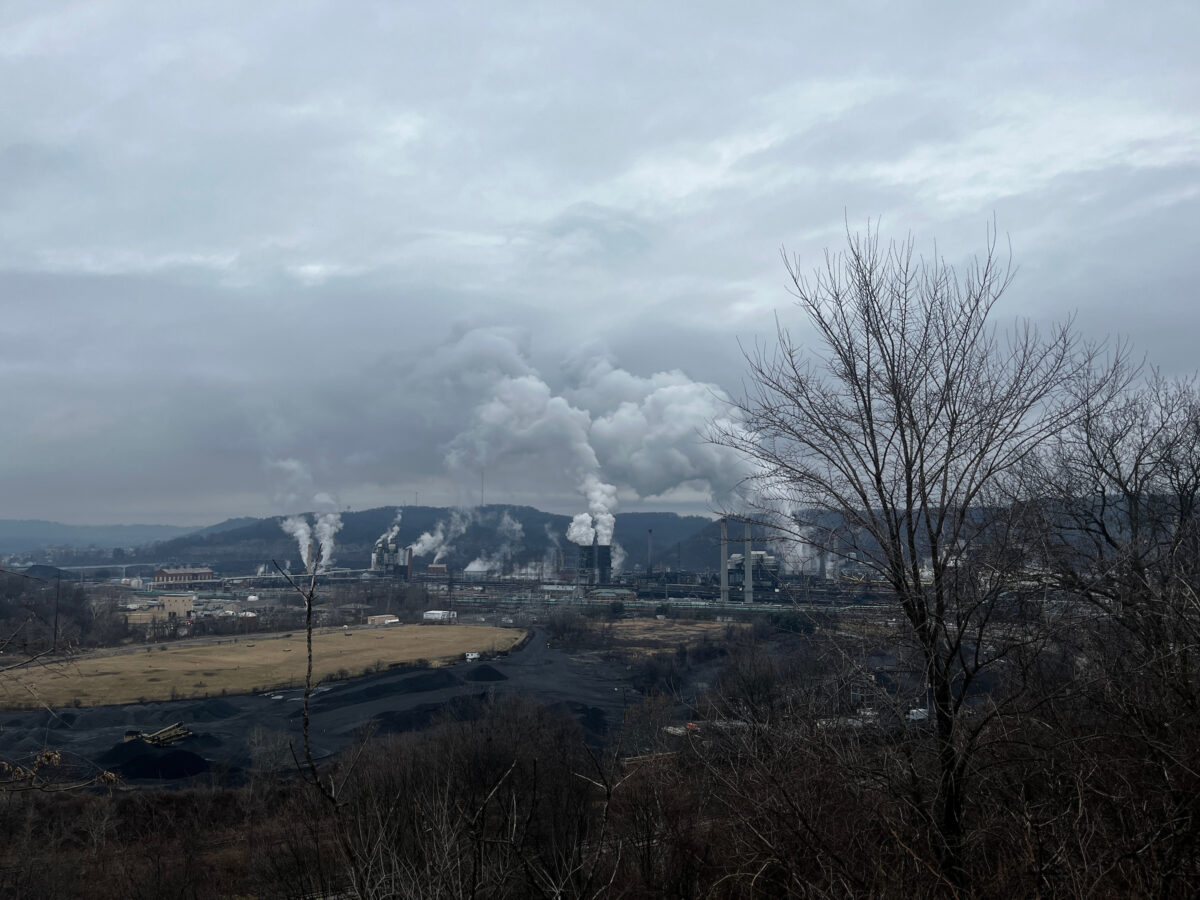At least 1.8 million pounds of industrial air pollutants were discharged in the greater Pittsburgh area in 2021, more than half from U.S. Steel’s Clairton coke works that bakes coal into a form usable to produce steel, according to the most recent federal records.
The data was self-reported by 58 industrial facilities to the U.S. Environmental Protection Agency. It was collected and published earlier this month by the PennEnvironment Research and Policy Center, citing the top 10 industrial air polluters in Allegheny County. They are required to report emissions to the EPA’s Toxics Release Inventory, which is available online.
The aggregate total emissions from those 10 was 1.4 million pounds, including some substances such as benzene that are linked to cancer, birth defects and reproductive problems. The environmental group called for the Allegheny County Health Department to take further cleanup measures, citing 179 days of “elevated levels of ozone ‘smog’ and/or particulate pollution” in 2022.
Industrial pollution is a major factor in greater Pittsburgh’s air quality, according to PennEnvironment. It noted tens of thousands of people living within a 3-mile radius of each of those 10 industrial discharges. With prevailing winds from the west, that means residents east of them are often downwind.
Traffic, including diesel trucks, are another significant factor, and some pollution blows into the region from places upwind, said Zachary Barber, clean air advocate for PennEnvironment. “But the thing that really distinguishes Pittsburgh’s air quality as uniquely bad is our intense local industrial emissions.”
Other airborne industrial toxics include lead, chromium, hydrogen sulfide and the tiny particulates that people can inhale into their lungs.
U.S. Steel’s Clairton coke plant south of Pittsburgh reported releases of 1.1 million pounds of discharges in 2021, according to the EPA. About 75% comprised hydrogen sulfide, ammonia and hydrochloric acid.
PennEnvironment also estimated toxicity by applying the U.S. EPA’s Risk Screening Environmental Indicators metric to the discharges, which factor toxic specific substances they emitted. In the report posted on its website, by that measure Clairton accounted for 23% of the 10 companies’ toxic hazard.
ATI Flat Rolled Products Holdings Inc. produced only 2,216 pounds of reported emissions but nearly matched Clairton’s toxicity factor because its discharges included chromium, nickel and lead, all considered carcinogens and threats to reproductive and developmental health.
ATI in Brackenridge, northeast of Pittsburgh by the Allegheny River, makes titanium alloy and other specialty metal products with its electric arc furnaces.
Company spokeswoman Natalie Gillespie said it captures more than 99 percent of what it generates, emitting less than 1 percent through its baghouses, air pollution control devices and dust collectors that remove particulates or gas released from commercial processes.
The facility reduced its air emissions by 55 percent from 4,973 pounds in 2020, Gillespie said. “We deploy the best-available technology for emission control and the most sustainable energy systems in our new equipment to manufacture essential materials and continue to improve.”
According to PennEnvironment, ATI had been the county’s most-toxic industrial air polluter in 2019.
In a prepared statement, U.S. Steel said its Clairton plant in 2021 “continued its relentless pursuit of environmental excellence” while ramping up production to meet increased demand. “The plant continued to maintain its excellent environmental performance in terms of combustion stack and fugitive compliance.”
The company said the Liberty monitor 2 miles away “was in attainment with National Ambient Air Quality Standards for all criteria pollutants.”
In its report on 2021 operations, U.S. Steel said the plant located on 392 acres along 3.3 miles of the Monongahela River employed 1,400 people. It had the capacity to produce about 4.3 million tons of high-grade metallurgical coke per year in 10 coke batteries consisting of 708 ovens and was the largest producer in the western hemisphere.
It supplies coke for iron and steel production at facilities including its Mon Valley Works’ Edgar Thomson Plant. It’s located in Braddock, east of Pittsburgh and across the Monongahela River from Kennywood Park. Thomson ranked as the ninth biggest industrial air polluter in Allegheny County that year, according to the EPA data, with almost 112,000 pounds of releases.
PennEnvironment said the Clairton plant was in violation of the federal Clean Air Act in every quarter of the three years ending last March.
The EPA report noted measures that have been taken at Clairton to reduce discharges of benzene and ammonia with recirculation in production processes and modified equipment.
U.S. Steel shut down its oldest three Clairton batteries recently, concluding the first week in April, spokesman Andrew Fulton said. The closings will reduce emissions, he said, adding those batteries’ environmental compliance rate was more than 99% last year.
Employee retirements and reassignments offset the roughly 130 positions lost by the closings, and the works now employ 1,300 people, Fulton said. Its emissions report for 2022 wasn’t complete yet, he said Wednesday.
The industries are required to report their 2022 emissions by July 1, EPA spokesman David Sternberg said. The agency hasn’t received reports yet or analyzed a trend, he said.
The industrial air pollution for Allegheny County in 2021 increased to 1.8 million pounds from 1.56 million pounds the year before, according to the EPA. The top five chemicals released were ammonia, hydrogen sulfide, hydrochloric acid, methanol and aluminum.
The other seven companies on the PennEnvironment list are Thermal Transfer Corp. in Duquesne, PPG Industries Inc. Springdale Complex, Universal Stainless & Alloy Products Inc. in Collier, TMS International LLC in Braddock, Holtec Manufacturing in East Pittsburgh, Neville Chemical Co. on Neville Island, and McConway & Torley LLC in Lawrenceville.

Michael Virtanen
Michael Virtanen is a retired Associated Press reporter and Guild member living in Mt. Lebanon who contributed this story to the striking Pittsburgh new workers.


